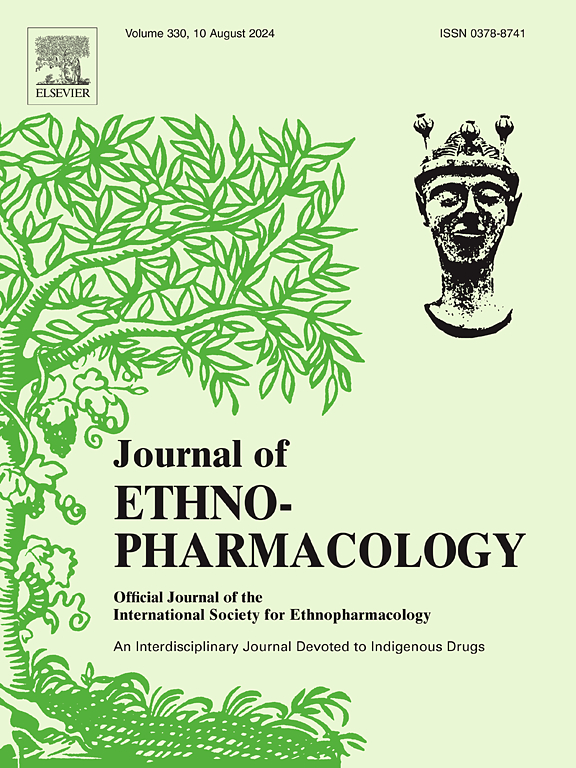Lycii Fructus and Chrysanthemum Flos, a Chinese medicine herbal pair, ameliorates retinal degeneration of mice induced by sodium iodate and protects Müller cells from oxidative stress
IF 4.8
2区 医学
Q1 CHEMISTRY, MEDICINAL
引用次数: 0
Abstract
Ethnopharmacological relevance
The combination of Lycii Fructus (LF) and Chrysanthemum Flos (CF) is a well-known herbal pair utilized in Chinese medicine for the treatment of retinal degeneration diseases commonly found in the elderly, such as age-related macular degeneration (AMD). However, the precise mechanisms of action mechanism and active constituents responsible for the therapeutic effects of the LF-CF herbal pair in improving AMD remain unknown.
Aim of the study
This study aims to evaluate the effect of the LF-CF herbal pair on alleviating retinal damage and apoptosis in Müller cells of a dry AMD mouse model, especially its role in enhancing oxidative stress in the retina. Moreover, it endeavors to clarify the underlying action mechanisms and identify the bioactive ingredients in the LF - CF herbal pair that act on Müller cells to alleviate oxidative stress.
Materials and methods
A mice model of dry AMD was established through intraperitoneal administration of sodium iodate. Various solvents were employed to prepare extracts of the LF-CF herbal pair. The impact of these solvent extracts on ameliorating oxidative damage and determination of oxidation index in the retina was assessed. The ability of LF-CF herbal pair on regulating Nrf2/HO-1 signaling pathway in model mice was also detected. The MIO-M1 cell cultures were employed to assess the impact of extracts on protecting cells from oxidative damage caused by sodium iodate. The cell cultures were also utilized to investigate the potential mechanism of action and identify the active components involved.
Results
The LF-CF herbal pair extracts showed evident protective effects on the mouse retina against sodium iodate-induced oxidative damage. They maintained retinal structural integrity and inhibited apoptosis. Among the extracts, the aqueous and 70 % ethanol ones were more effective in preventing retina injury. These two extracts enhanced antioxidant enzyme activity, reduced oxidative products in the experimental mice's retina, reversing the down-regulation of glutamine synthetase (a Müller cell marker). In vitro, the aqueous and 70 % ethanol extracts of the LF-CF herbal pair also protected MIO-M1 cells from sodium iodate-induced oxidative stress via regulating caspase-dependent and Nrf2/HO-1 signaling pathways. Lycium barbarum polysaccharides and luteolin are likely the active ingredients responsible for these effects.
Conclusions
The LF-CF herbal pair demonstrated the ability to mitigate oxidative stress in the retina and suppress apoptosis in Müller cells through the regulation of caspase-dependent and Nrf2/HO-1 signaling pathways. These findings contribute to the growing body of scientific evidences supporting the potential of LF-CF herbal pair as a viable therapeutic option or preventive measure for dry AMD.

求助全文
约1分钟内获得全文
求助全文
来源期刊

Journal of ethnopharmacology
医学-全科医学与补充医学
CiteScore
10.30
自引率
5.60%
发文量
967
审稿时长
77 days
期刊介绍:
The Journal of Ethnopharmacology is dedicated to the exchange of information and understandings about people''s use of plants, fungi, animals, microorganisms and minerals and their biological and pharmacological effects based on the principles established through international conventions. Early people confronted with illness and disease, discovered a wealth of useful therapeutic agents in the plant and animal kingdoms. The empirical knowledge of these medicinal substances and their toxic potential was passed on by oral tradition and sometimes recorded in herbals and other texts on materia medica. Many valuable drugs of today (e.g., atropine, ephedrine, tubocurarine, digoxin, reserpine) came into use through the study of indigenous remedies. Chemists continue to use plant-derived drugs (e.g., morphine, taxol, physostigmine, quinidine, emetine) as prototypes in their attempts to develop more effective and less toxic medicinals.
 求助内容:
求助内容: 应助结果提醒方式:
应助结果提醒方式:


